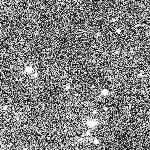Cosmic rays are the most common "false" FMOs. This image flaw is a frequent occurance in telescope image data but with experience a reviewer can quickly differentiate between a cosmic ray and a real object. A cosmic ray is most easily identified by studying the width and the edge of the trail. Cosmic rays are typically very narrow (less than two pixels wide) and have sharp edges - meaning they have a large brightness change between background level and the edge pixels of the FMO candidate. This is in contrast to the desired fuzzy profile (a gradual change in brightness from the background to the peak at the center of the FMO). A reviewer should not report cosmic rays.
NON-REPORTABLE: Classic Cosmic Ray
CHARACTERISTICS:
Notice the sharp edges due to a large color change between background level and each pixel on the edge of the FMO candidate. The edges are so sharp that, upon close inspection, you see pixelation (click the image for a larger view.) Compare with the fuzzy star images, this trail does NOT look like a smeared star signal. Two shorter cosmic rays also appear on the image (the first between the ray trail and the star and the second along the bottom edge of the image.)
NON-REPORTABLE: Skipping Cosmic Ray
CHARACTERISTICS:
Here the pixelation is so obvious that the trail has gaps.
NON-REPORTABLE: Smeared Cosmic Ray
CHARACTERISTICS:
This cosmic ray did not hit the CCD at as shallow an angle as the two images to the left; hence the long pixelated trail was avoided. Something in the image gives this cosmic ray a "fuzzier" look at first glance, but in the larger image (click on image above for the larger scale) you will see that the FMO candidate's edge is too pixelated to be anything other than a cosmic ray.




